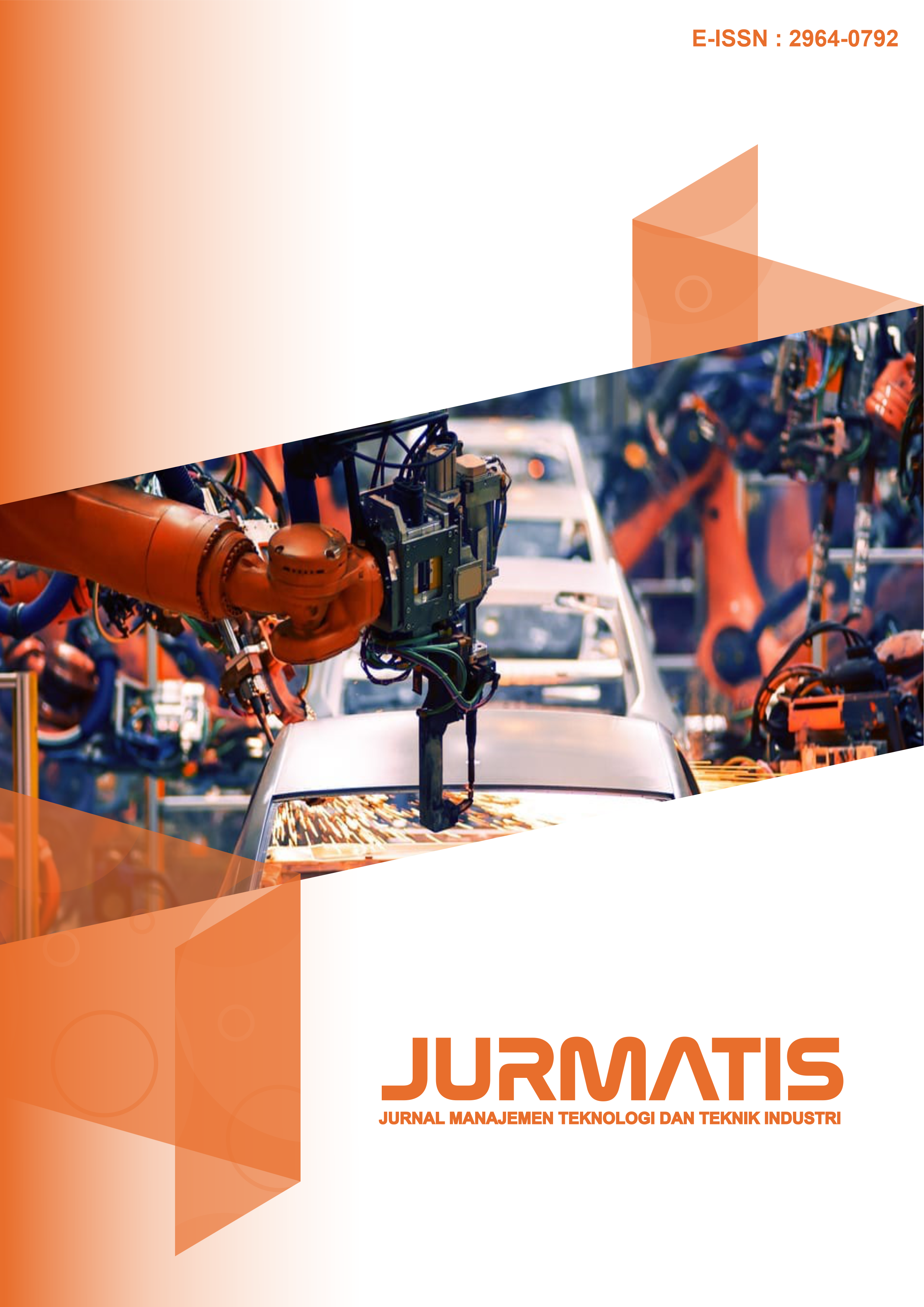Analisis Sistem Kerja Untuk Meningkatkan Produktivitas Pegawai Negeri Sipil Dengan Pendekatan Macroergonomic Analysis And Design
DOI:
https://doi.org/10.30737/jurmatis.v4i1.1969Keywords:
MEAD, Productivity, Work SystemAbstract
The work system greatly affects the performance of employees until it finally results in the employee being productive or not. A good work system will provide security and comfort to employees when doing work. From this, it is expected that employees can work more actively and can achieve the targets that have been set. This study aims to identify the work system applied to the Community and Village Empowerment Service, and evaluate the work system in order to get a better system to increase productivity. Macroergonomics Analysis and Design (MEAD) approach is used to evaluate the work system with structured and systematic steps. From the results obtained, it is known that the work system implemented by the DPMD has been running effectively and efficiently in accordance with the established vision and mission. While the factors that affect productivity are the physical environment, work equipment, working conditions, and organizational systems. From the calculation of %HR Reserve and Cardiovascular Load (%CVL) the value is 56.34% while the rest time is -0.083. From these results, it is known that the rest time given is sufficient and there is no need for additional rest periods.
Sistem kerja sangat mempengaruhi kinerja pegawai hingga akhirnya menghasilkan pegawai tersebut produktif atau tidak. Suatu sistem kerja yang baik akan memberikan keamanan dan kenyamanan pada pegawai saat melakukan pekerjaan. Dari hal tersebut diharapkan pegawai bisa bekerja lebih aktif dan dapat mencapai target yang telah ditetapkan. Penelitian ini bertujuan mengidentifikasi sistem kerja yang diterapkan pada Dinas Pemberdayaan Masyarakat dan Desa, serta mengevaluasi sistem kerja tersebut guna mendapatkan sistem yang lebih baik untuk dapat meningkatkan produktivitas. Digunakan pendekatan Macroergonomics Analysis and Design(MEAD) untuk mengevaluasi sistem kerja dengan langkah terstruktur dan sistematis. Dari hasil yang didapatkan, diketahui sistem kerja yang diterapkan oleh DPMD sudah berjalan efektif dan efisien sesuai dengan visi dan misi yang sudah ditetapkan. Sedangkan faktor-faktor yang mempengaruhi produktivitas yaitu ada lingkungan fisik, peralatan kerja, kondisi pekerjaan, dan sistem organisasi. Dari perhitungan % HR Reserve dan Cardiovaskuler Load (% CVL) di dapatkan nilai 56,34% sedangkan waktu istirahat -0,083. Dari hasil tersebut diketahui waktu istirahat yang diberikan sudah cukup dan tidak perlu adanya penambahan waktu istirahat.
References
D. Mayasari and F. Saftarina, “Ergonomi sebagai Upaya Pencegahan Musculoskeletal Disorders pada Pekerja,†JK Unila, 2016, doi: 10.1055/s-0034-1366979.
W. A. M. Sari, B. Suhardi, and I. W. Suletra, “PENGARUH KONDISI SISTEM KERJA TERHADAP STRESS KERJA DENGAN MENGGUNAKAN MACROERGONOMIC ORGANIZATIONAL QUESTIONNARE SURVEY ( MOQS ),†J. Intech, vol. 7, no. 1, pp. 30–38, 2021.
D. R. L and T. Wibawa, “EVALUASI SISTEM KERJA DI INDUSTRI KERAJINAN BATIK KAYU SANGGAR ARJUNA DESA KREBET PAJANGAN BANTUL DENGAN PENDEKATAN MACROERGONOMIC ANALYSIS AND DESIGN,†J. OPSI, vol. 9, no. 2, pp. 79–84, 2016.
T. W. Tumewu and R. A. Rachmadi, “Analisis Karakter Organisasi Tenaga Kependidikan UNIKA De La Salle Manado menggunakan Macroergonomic Organizational Questionaire Survey,†J. SAINTEK, vol. 4, no. 1, pp. 1–7, 2020.
M. M. Tambunan, D. Wahyuni, and J. Kristanto, “PERANCANGAN FASILITAS KERJA DI BAGIAN PRODUKSI PT . XYZ DENGAN MENGGUNAKAN MACROERGONOMIC ANALYSIS AND DESIGN ( MEAD ),†J. Sist. Tek. Ind., vol. 18, no. 1, pp. 1–5, 2016.
D. S. Putri, W. B., Wahyudin, and H. Hamdani, “Analisis Sistem Kerja untuk Meningkatkan Produktivitas Pegawai Negeri Sipil dengan Pendekatan Macroergonomic Analysis and Design.,†J. Serambi Eng., vol. 6, no. 4, 2021.
K. Hariyanto and A. Hindratmo, “Identifikasi Sistem Kerja Dalam Mengurangi Muskuloskeletal Dan Risiko Cedera Pada Proses Manufaktur (Studi Kasus Pelatihan Mesin Bubut Mahasiswa Teknik Universitas Wijaya Putra Surabaya),†J. SENOPATI, vol. 2, no. 1, pp. 33–42, 2020.
M. C. Zulfa, M. Syahri, and D. R. L, “DESAIN FASILITAS KERJA ALAT PENEKUK AKRILIK MENGGUNAKAN METODE MACROERGONOMIC ANALYSIS AND DESIGN (MEAD) PADA CV. CAESAR ADVERTISING,†in Prosiding SENASTIK, 2016, pp. 34–39.
A. Haripurna and H. Purnomo, “Desain Perancangan Alat Penyaring Dalam Proses Pembuatan Tahu Dengan Metode Macro Ergonomic Analysis and Design ( MEAD ),†J. Ilm. Tek. Ind., vol. 16, no. 1, pp. 22–27, 2017, doi: 10.23917/jiti.v16i1.3845.
A. H. Pradini, D. Rachmawati, and G. Madyono, “PERBAIKAN SISTEM KERJA DENGAN PENDEKATAN MACROERGONOMIC ANALYSIS AND DESIGN ( MEAD ) UNTUK MENINGKATKAN PRODUKTIFITAS PEKERJA ( Studi kasus di UD Majid Jaya , Sarang , Rembang , Jawa Tengah ),†Jural OPSI, vol. 12, no. 1, pp. 36–47, 2019.
I. Mindhayani and H. Purnomo, “PERBAIKAN SISTEM KERJA UNTUK MENINGKATKAN PRODUKTIVITAS KARYAWAN,†J. PASTI, vol. 10, no. 1, pp. 98–107, 2016.
M. Tangahu, H. Purnomo, and A. Mansur, “Desain Sistem Kerja Mesin Pemipih Jagung yang Ergonomi untuk Meningkatkan Produktivitas,†J. Prozima, vol. 1, no. 2, pp. 90–98, 2017, doi: 10.21070/prozima.v1i2.1301.
G. M. Ayu, I. H. Nasution, and I. Nazlina, “PENINGKATAN KUALITAS LAYANAN KERETA API SRIBILAH DENGAN PENDEKATAN MACROERGONOMICS ANALYSIS AND DESIGN,†e-Jurnal Tek. Ind. FT USU, vol. 3, no. 2, pp. 8–12, 2013.
T. Ristyowati and T. Wibawa, “Perancangan Sistem Kerja untuk Meningkatkan Hasil Produksi melalui Pendekatan Macroergonomic Analysis And Design di Sentra Industri Batik Ayu Arimbi Sleman.,†OPSI, vol. 11, no. 2, pp. 125-133., 2018.
T. Ristyowati and T. Wibawa, “PERANCANGAN SISTEM KERJA MELALUI PENDEKATAN MACROERGONOMIC ANALYSIS AND DESIGN,†J. OPSI, vol. 11, no. 2, pp. 125–133, 2018.
T. Aprianto and H. Purnomo, “DESAIN PENCETAK DAN PENGEPRES TAHU PADA UKM TAHU MENGGUNAKAN METODE MACROERGONOMIC ANALYSIS AND DESIGN (MEAD),†in Seminar Nasiona; IENACO, 2014, pp. 22–28.
R. Wahyuniardi and D. M. Reyhanandar, “Penilaian Postur Operator Dan Perbaikan Sistem Kerja Dengan Metode Rula Dan Reba,†J@ti Undip J. Tek. Ind., vol. 13, no. 1, p. 45, 2018, doi: 10.14710/jati.13.1.45-50.
W. Andika and C. D. Kusmindari, “REDESAIN PUSH UP DETEKTOR MENGGUNAKAN METODE MACROERGONOMIC,†in Bina Darma Conference on Computer Science, 2019, pp. 2203–2213.
H. Iridiastadi and Yassierl, Ergonomi Suatu Pengantar. Bandung: Penerbit PT Remaja Rosdakarya, 2014.
W. Sumarmi, “Evaluasi fasilitas lingkungan kerja di puskesmas wono ayu menggunakan metode macroergonomic analysis and design,†J. Tekmapro, vol. 12, no. 02, pp. 22–31, 2019.
Downloads
Published
Issue
Section
License
Authors who publish with this journal agree to the following terms:
(1) The copyright of published articles will be transferred to the journal as the publisher of the manuscript. Therefore, the author needs to confirm that the copyright has been managed by the publisher with the Publication Right Form which must be attached when submitting the article.
(2) Publisher of JURMATIS is Kadiri University.
(3) The copyright follows Creative Commons Attribution“ShareAlike License (CC BY SA): This license allows to Share copy and redistribute the material in any medium or format, Adapt remix, transform, and build upon the material, for any purpose, even commercially.



















